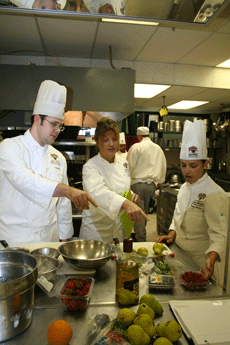Men and women dressed in white chef coats and hats shuffle from their cutting boards to their bubbling pots. Sweet and savory aromas fill the busy kitchen. One cook brings a sample for the chef to taste: “Mmm, you’re on target now,” the chef replies. Similar to a restaurant kitchen, one aspect of Product Development and Evaluation, a culinary class at Nicholls, is for students to produce an original creation.
Travis McClain, culinary senior from Jackson, Miss., says his group wanted to develop fruit sushi because eating sushi has become a popular trend.
“You don’t really see sweet sushi, you usually see more savory flavors,” McClain says.
Experimentation plays a big role in the class. The group making fruit sushi has been testing different fruits and sweet products. McClain says they have been cooking the rice in different fruit juices and are trying to find the perfect type of paper to use, either rice or tapioca paper. However, they may decide to eliminate paper altogether.
“Rolling sushi is hard,” McClain says.
In addition to developing a creative product, a crucial element of the class is for the product to be marketable. To ensure the product’s success students must research popular trends and determine what their target groups will be.
“You have a one in a million shot of making a successful product without doing the research,” Anne Parr, assistant dean of the Chef John Folse Culinary Institute and instructor of the class, says.
In line with the health food trend, one group is developing “Cajun Lean Cuisines.” They are reducing fat and using whole-wheat pastas, organic vegetables and brown rice.
The group plans to create reduced-fat crawfish toufe, shrimp Creole and shrimp toufe. They may also experiment with a reduced-fat gumbo, Terrence Johnson, culinary junior from Thibodaux, says.
Another group found inspiration from an alternative source.
“I was getting ready to go to school one morning, and I wanted red beans and rice and a biscuit. Popeye’s was not open that early, and I hadn’t done my homework. I remembered I needed to come up with an idea for class, so I began thinking about seafood and biscuits – that’s how my mind works,” Eric Gros, culinary senior from Pierre Part, says.
Gros’ group’s product is called “Cajun Stuffed Poboys.” A partially baked bread filled with a Cajun seafood stuffing, the product would be found in the freezer section of a grocery store.
Because feedback is essential to a product’s marketing, the class will give 50 samples of each creation to students and faculty, who will give evaluations.
Nancy Wilson, culinary senior from Baton Rouge, says she would like to market her group’s product outside of the class assignment. Her group’s product, tequila sorbet, has not been marketed locally, she says.
“We’re hoping that if the response is good we will be able to go forward with it,” Wilson says.
Parr says in the future she would like business students to become involved with the Product Development and Evaluation class, particularly the marketing aspect.
“Our students are great with coming up with ideas and cooking, but they’re not really into the marketing aspect of it,” Parr says.
No students in Product Development and Evaluation have been able to successfully market their product in stores, Parr says.
The best product students have developed in her class was “Cajun Corndogs,” Parr says, which contained red beans and rice with sausage.
“It was like something you would see at Jazz Fest,” Parr says.
Designing the packaging for the product is also a requirement of the class.
One group, who is developing “Upscale Frozen Soul Food,” will market its collard greens in a boiling bag.
“People enjoy eating soul food but might not have access to fresh greens in different parts of the country. And if you buy it in a can, it’s gross,” Taylor Price, culinary senior from Little Rock, Ark., says.
Another group, who will be brewing beer from scratch, plans to bottle its product.
The group is making a basil pilsner beer and will experiment with different fruit flavors, such as honey and apple.
“I always wanted to learn how to brew beer,” Tim Mohon, culinary sophomore from Raceland, says. “I have also been interested in the unique styles of beer.”
Only time will tell if consumers will see “Cajun Lean Cuisines” or tequilla sorbet at Rouses.
Regardless if the students successfully market their products, Parr says students will benefit from learning how to target a specific group of consumers when developing a product.
And they will have enjoyed being creative, too, she says.








